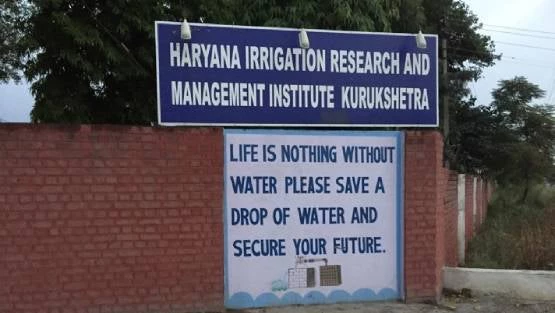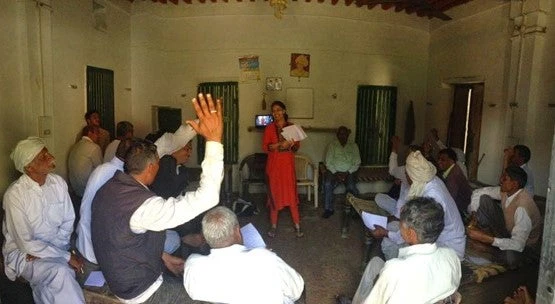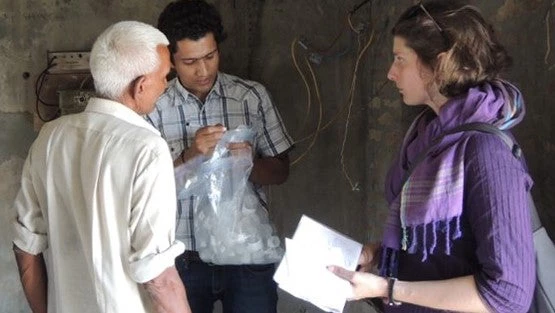Water tables are being depleted at accelerated rates in Northern India where farmers grow water-intensive crops such as rice. Groundwater extraction from this region of India accounts for roughly 25% of all groundwater extraction worldwide, according to a report in Nature Geoscience. We highlight findings and discoveries from our study in Haryana, India, a state grappling with water depletion featured in the Journal of Environmental Economics and Management.
The Training Dilemma
In our initial discussions about water depletion in the state of Haryana, the prevailing sentiment among agronomists and engineers was that conventional training methods had fallen short of their intended impact. Despite skepticism about the impact of training programs on water scarcity, we believed it was essential to ground these sentiments in evidence.

© K. Vasilaky
Collaborating with the Haryana Irrigation Management Institute and Haryana Agricultural University, we designed a study that introduced Alternate Wetting and Drying (AWD) technique—a part of the System of Rice Intensification system. AWD involves alternating wetting and drying of fields, which, when compared to traditional constant flooding, has resulted in significant water-saving benefits while not reducing yield in controlled agronomic plots. However, controlled agronomic studies are not a reflection of whether a) farmers will adopt a practice, b) when they will adopt it, and c) whether they execute the process in the same way as in controlled agronomic studies.
For farmers who both own and control the use of their pump, training in water-reducing techniques can help reduce water consumption without affecting yields. Our study revealed that AWD training led to a notable reduction in water pumping hours among farmers in Haryana. Yet, the low-cost training offers more economical solutions than other alternatives, potentially saving governments significant irrigation costs. Overall, our training led to a 2.2-hour decline during AWD weeks, or a 22% decline in the total weekly pumping hours. Our results align with the average decline observed in other economic studies on water management in Southeast Asia but is much less costly than other solutions like leveling land, reducing subsidies for electricity or subsiding farmers who reduce their water use.
From the perspective of the state, we estimate that AWD training could provide a 7-11% reduction in government spending on irrigation. In addition, AWD training could also lessen the overdraft problem by saving 0.4-0.6 bcm annually.
Ripe for Change?
From the perspective of the farmer, what is the incentive to adopt AWD? AWD reduces water use but does not necessarily increase output. And because water comes from shared aquifers, a fundamental question is why wouldn't farmers free-ride on the water conservation efforts of others? The uniqueness of our study's context was that farmers owned their pumps and were highly aware of local water issues. Farmers were aware of the consequences of water depletion: increased extraction costs and deteriorating water quality.

In terms of extraction costs, farmers in our sample reported a little over 0.61 m (2 ft) decrease in their water level per year since the time that their current pump was installed. Extracting water from deeper depths requires farmers to lower their pumps and sometimes purchase pumps with increased horsepower.
In terms of water quality, we assessed farmer knowledge while collecting long-term water quality samples. We left water sampling bottles with the household respondent to collect weekly samples. In many other water-stressed areas of India, this task requires a lot of training and discussion; however, the farmers we asked to collect water samples would often ask questions regarding the conductivity and general quality of their water. As we continue to work in India, this base level of water quality knowledge appears to be increasing, perhaps signaling that stress over water quality and quantity are permeating household discussions and a desire for change.

The Road Ahead
In addition to the results from our study, we learned about two other factors that should be considered in future research on water depletion: optimizing existing water infrastructure and the interdependency between water access and soil quality. According to the 2021 ASCE US Infrastructure report card, approximately 6 billion gallons of treated drinking water are lost through leaky pipes or because of breakages every day across the US. Leaky infrastructure needs to be considered when studying agricultural groundwater use. Similarly, the degree to which water is effective in promoting crop growth depends on the absorptive capacity of nutrients in the soil. Inputs and water use should likely be addressed simultaneously.
The study described in this blog was presented by the authors as part of the “Doing Sustainable Development: Everything you wanted to know but were afraid to ask” seminar series, which presents flagship reports and disseminates key knowledge and experience relevant to the Sustainable Development Practice Group of the World Bank. The series aims to spark and inform debate on topical issues that are foundational to the Bank's mission and connect the operational and analytical work that are key to achieving a green and transition.
Related report
The Hidden Wealth of Nations: The Economics of Groundwater in Times of Climate Change





Join the Conversation